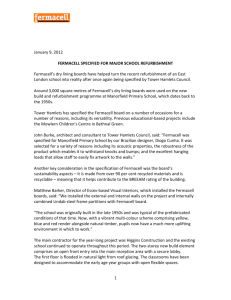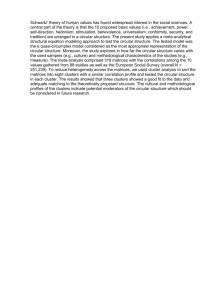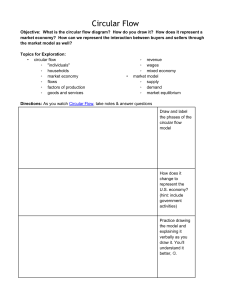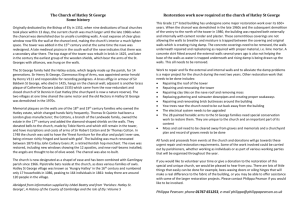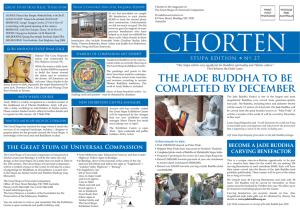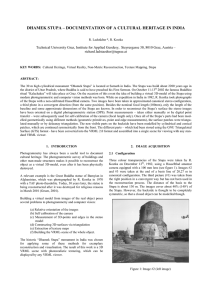Architectural History Final Exam
advertisement
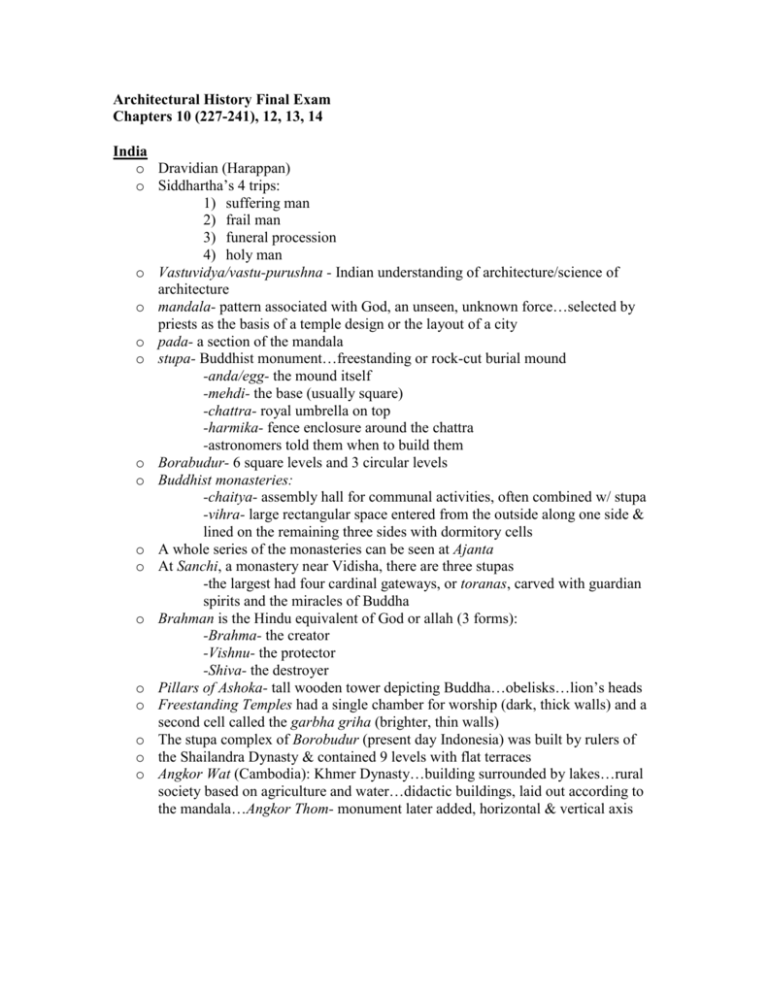
Architectural History Final Exam Chapters 10 (227-241), 12, 13, 14 India o Dravidian (Harappan) o Siddhartha’s 4 trips: 1) suffering man 2) frail man 3) funeral procession 4) holy man o Vastuvidya/vastu-purushna - Indian understanding of architecture/science of architecture o mandala- pattern associated with God, an unseen, unknown force…selected by priests as the basis of a temple design or the layout of a city o pada- a section of the mandala o stupa- Buddhist monument…freestanding or rock-cut burial mound -anda/egg- the mound itself -mehdi- the base (usually square) -chattra- royal umbrella on top -harmika- fence enclosure around the chattra -astronomers told them when to build them o Borabudur- 6 square levels and 3 circular levels o Buddhist monasteries: -chaitya- assembly hall for communal activities, often combined w/ stupa -vihra- large rectangular space entered from the outside along one side & lined on the remaining three sides with dormitory cells o A whole series of the monasteries can be seen at Ajanta o At Sanchi, a monastery near Vidisha, there are three stupas -the largest had four cardinal gateways, or toranas, carved with guardian spirits and the miracles of Buddha o Brahman is the Hindu equivalent of God or allah (3 forms): -Brahma- the creator -Vishnu- the protector -Shiva- the destroyer o Pillars of Ashoka- tall wooden tower depicting Buddha…obelisks…lion’s heads o Freestanding Temples had a single chamber for worship (dark, thick walls) and a second cell called the garbha griha (brighter, thin walls) o The stupa complex of Borobudur (present day Indonesia) was built by rulers of o the Shailandra Dynasty & contained 9 levels with flat terraces o Angkor Wat (Cambodia): Khmer Dynasty…building surrounded by lakes…rural society based on agriculture and water…didactic buildings, laid out according to the mandala…Angkor Thom- monument later added, horizontal & vertical axis China o o o o o o o o o o o o o Japan o o o o Qin Dynasty Xian Yangs Army: terracotta soldiers fang- neighborhood ming- porched, central room Roof types: -Ying-shan- without overhanging gables -Hsuan-shan- with overhanging gables -Wu-tien/Wu-chi- with five spines and four slopes -Hsieh-shan/Chiu-chi- nine spines -Tsan-chien- the pinnacle type (can be on a round structure) -Ch’ung-yen- with double eaves, an elaboration of Wu-tien/Wu-chi Toukung- system entailing both bracketing and cantaliever action via members that extended parallel to the rafters directly under the roof Ming-Tan- where the emperor performed pious ceremonies for the state Ch’ang-an- in the very center of a circular moat that enclosed a square platform was a four-winged structure around a court set on its own circular terrace. The Han emperor adjusted his behavior to nature’s cycles, moving from hall to hall as the seasons changed and completing a revolution in the course of the year…city without a plan…destroyed by internal rebellion Great Wall built to protect; encloses best farmland Hang tu- method of rammed earth construction: build frame, pack with earth, strip away support Li Chien standardized weights and measures Confucius: -jin- courtyard for the family -jian- planning system, architectural design Beijing- forbidden city, emperor’s city Pagoda- stacked stupa Jomon=primative, Yayoi=houses on platforms Shintoism- God is in everything Ise Naiku- on mountainside…irregular path to main site…20 year cycle The Americas o North America: Iriquois= longhouses, Adena= moundbuilders -palisading- stripping bark off trees & putting them in the ground to make walls o South America: -Incans: “great road builders” -Tiahuanaco: very religious -Nazca lines- markings carved into soil to reveal chalk below it -Cuzco was the Incan capital -typical Incan towns were laid out in a grid system (castrum) -Machu Pichu o Central America: -the Olmec -Jaguar baby= religious figure -Cuicuilco in the Pedregal- circular pyramid with four conical stages -La Venta- religious & civic center…surrounded by swamps…pyramids were rounded and fluted…two adjacent courts to the north: 1st was framed by parallel mounds on the east & west sides, 2nd was a sunken rectangle paved with colored clays and edged with columns of basalt…further north another circular mound rose over a tomb & beyond this three heads of basalt faced north like guardian figures…manmade rectangular hill, pits lined with stone, flat-topped altars -Mayans: *Tikal: ceremonial center *Coba: (Yucatan Peninsula) limestone plain with 6000 buildings buried under the jungle *Teotihuacan: greatest city of its day…”Avenue of the Dead”= main axis/road…public forum/square at one end & pyramids of the sun & moon at the other…made up of about 4000 smaller pyramids…roadways & raised areas for agriculture…made of local materials (plaster)…axis does not run true north (1- oriented towards Cerro Gordo, which provided water or 2- the heavens shifted)… “The Great Compound”= marketplace & administrative center…tableros- a rectangular framed panel cantilevered over a sloping wall *each resident had their own pyramid -Itza (Toltecs from Mexico): City of Chichen Itza… “the Nunnery”= stone building…ball courts -Aztecs: Tenochtilan…used to be located on a lake (floating city, houses built on stilts)…steep pyramid forms…renewing cycle: rebuilt everything at the end of each cycle (every 50-something years or so)…Quetzalcoatl=god -Cortes wipes out the Incans and Aztecs Europe o Rome falls…no supreme rule of law…church steps in…St. Benedict’s rule o Guilds: localized accountability o The Franks -defenders of Christianity -seen as Barbarians -Charles Martel -Charlemagne attempts to recreate the Roman Empire -Palatine Chapel at Aachen, Germany: by Odo of Metz…large complex…westwork= the aggrandized end of the Church…rose window…towers o Abbey at Cluny- Abbot Berno…decorations (frescoes)…monks went “crazy with power”…relics are important -Criticism: Bernard of Clairaux- Cistercian monk who wanted to create a simple city of god Romanesque o wanted to recreate the scale of Roman buildings o Santiago de Compostella o St. Sernin o St. Foi o Earl’s Barton, England- “shortwork” o “Double Ender” Church o Speyer Cathedral, Germany o Church of the Holy Apostles @ Cologne o St. Michael’s @ Hildesheim o Italy -Pisa -St. Ambrogio @ Milan o Bastide- launching points for crusders…resembles Roman castrum…towns form outside walls…Aigues Morte o St. Denis- royal monastery (burial place of Frankish kings) built by Abbot Suger -refractive, light filled effects: precious stones, stained glass -double ambulatory with complex rib vaulting -rose window (round) -transitional building (defensive, fortified aspects) o Conversi- lower class of monks o Cluny- principal abbey of the Cluniac order built by Gunzo o Lynch Gate- a door in the north transept arm which was used when bodies were carried to the graveyard after a funeral Castles o Fortified buildings to protect from Islam invaders… “Residential Romanesque”…monasteries were subject to battle as well o LeKrak des Chevaliers- outer wall, inner wall, upper ward, lower ward o Crenellations- device from which you can wage war: shoot and then step behind for protection o Machicolation- area at the top of the wall, bottom could open & things could be dropped (rocks, arrows) o Bailey- open area inside the castle o Keep/motte/dojon- tower…at the center (last resort, innermost building, most protection)…built all the way down to bedrock so that no one could dig in o “Motte & Bailey” type of layout with an open area and tower o Thick walls so that the people inside can have the best view of who is outside o Tower of London Gothic o A sophisticated mutation of the familiar o God the great architect o All about light o Barrel vaults exert side thrusts o Rib vaulting o Cross vaulting o Durham Cathedral


